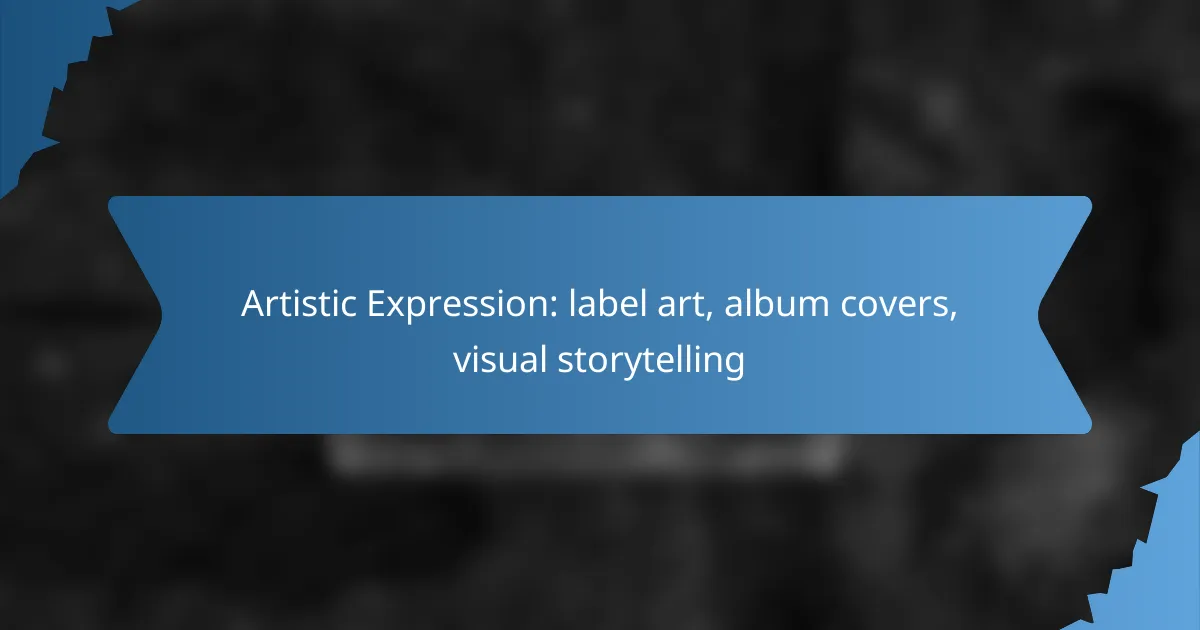Artistic expression through label art and album covers serves as a powerful medium for visual storytelling, engaging audiences on a deeper emotional level. In Australia, these designs not only reflect cultural nuances but also encapsulate the essence of the music and products they represent. By leveraging tools like Adobe Illustrator and Canva, artists can create compelling visuals that resonate with their target audience and enhance their overall narrative.
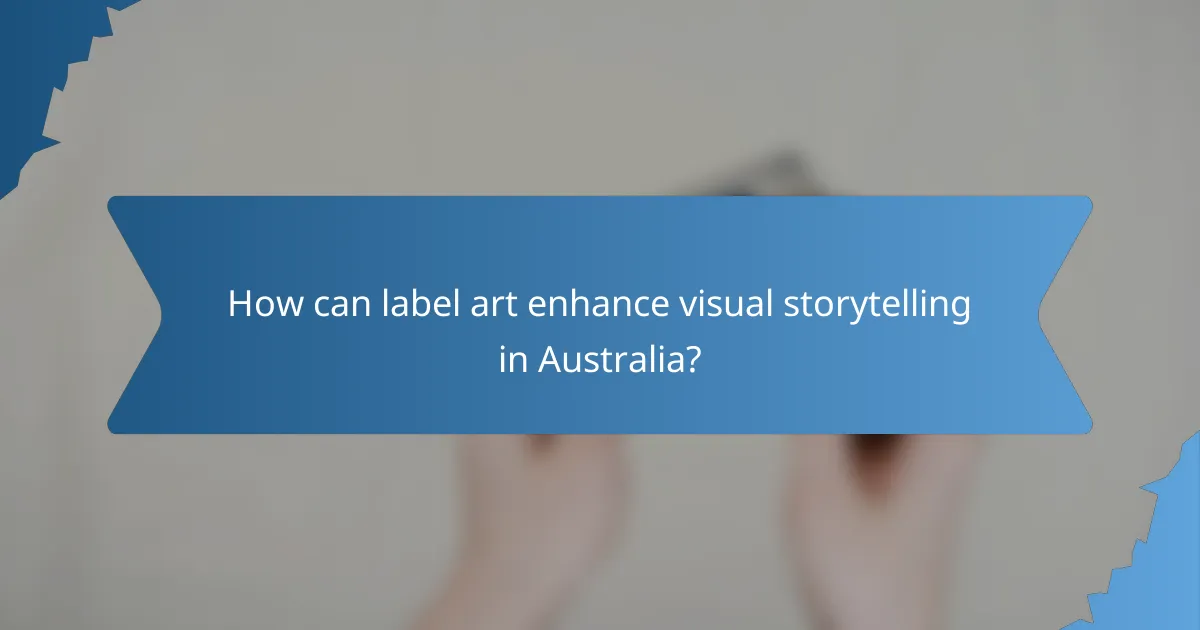
How can label art enhance visual storytelling in Australia?
Label art plays a crucial role in visual storytelling by creating a compelling narrative that resonates with audiences. In Australia, effective label designs can capture cultural elements and evoke emotions, making them integral to the overall artistic expression of music and products.
Engaging designs
Engaging designs in label art attract attention and invite exploration. They often incorporate vibrant colors, unique typography, and striking imagery that reflect the essence of the music or product. For instance, Australian artists might use indigenous patterns or local landscapes to create a connection with their audience.
To create engaging designs, consider using a mix of contemporary and traditional elements that resonate with local culture. Aim for a balance between creativity and clarity to ensure the message is easily understood at a glance.
Brand identity reflection
Label art serves as a visual representation of a brand’s identity, helping to establish recognition and loyalty among consumers. In Australia, brands can leverage local symbols, colors, and themes to create a distinct identity that sets them apart in a competitive market.
When designing label art, ensure that it aligns with the overall brand strategy. Consistency in style, color palette, and messaging across different products reinforces brand identity and enhances consumer trust.
Emotional connection
Creating an emotional connection through label art can significantly influence consumer behavior. In Australia, labels that evoke nostalgia or resonate with cultural pride can foster a deeper bond between the audience and the product.
To achieve this, use imagery and storytelling techniques that reflect shared experiences or values. Consider incorporating elements that celebrate Australian heritage, such as local wildlife or iconic landmarks, to strengthen the emotional impact of the label art.

What are the best practices for creating album covers?
Creating effective album covers involves understanding your target audience, utilizing color psychology, and incorporating artist branding. These elements work together to ensure the cover resonates with listeners and reflects the music’s essence.
Understanding target audience
Identifying your target audience is crucial for designing an impactful album cover. Consider factors such as age, musical preferences, and cultural background to tailor the design effectively. For example, a cover aimed at younger audiences might feature bold graphics and modern typography, while one for a more mature audience may lean towards classic aesthetics.
Engaging with your audience through surveys or social media can provide valuable insights. This feedback can guide your design choices, ensuring that the final product aligns with what potential listeners find appealing.
Utilizing color psychology
Color psychology plays a significant role in visual storytelling for album covers. Different colors evoke various emotions; for instance, blue can convey calmness, while red often signifies passion or energy. Selecting a color palette that aligns with the album’s themes can enhance its overall impact.
When choosing colors, consider the genre of music as well. For example, vibrant colors may suit pop music, while darker tones might be more appropriate for rock or metal. Aim for a harmonious balance that draws attention and communicates the music’s mood effectively.
Incorporating artist branding
Artist branding is essential for creating a cohesive identity across all visual elements, including album covers. Incorporate recognizable logos, fonts, and imagery that reflect the artist’s style and previous works. This consistency helps build brand recognition and loyalty among fans.
Additionally, consider how the album cover fits within the artist’s overall narrative. Each release should contribute to a larger story, enhancing the listener’s experience and connection to the music. Avoid drastic changes in style unless they serve a specific artistic purpose.
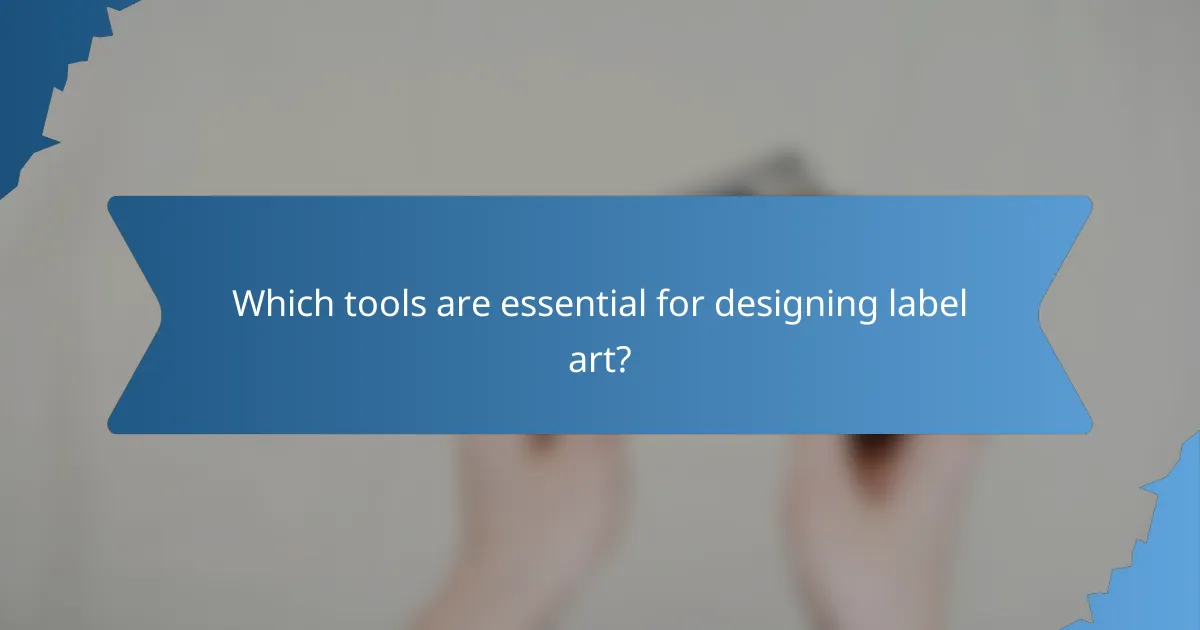
Which tools are essential for designing label art?
Essential tools for designing label art include software that allows for vector graphics, layout design, and digital painting. Popular choices like Adobe Illustrator, Canva, and Procreate cater to different skill levels and artistic needs.
Adobe Illustrator
Adobe Illustrator is a leading vector graphics software ideal for creating scalable label art. Its precision and versatility make it suitable for detailed designs, allowing artists to manipulate shapes, colors, and typography effectively.
When using Illustrator, take advantage of features like the Pen Tool for custom shapes and the Artboard feature for multiple design iterations. Be mindful of the learning curve; beginners may require tutorials to master its extensive capabilities.
Canva
Canva is a user-friendly online design tool that simplifies the creation of label art, especially for those without extensive graphic design experience. It offers a wide range of templates and drag-and-drop functionality, making it easy to produce professional-looking designs quickly.
While Canva is great for beginners, it may lack the advanced features of Illustrator. However, it is perfect for creating simple labels or promotional materials, and its collaborative features allow multiple users to work on a design simultaneously.
Procreate
Procreate is a popular digital painting app for iPad that excels in creating hand-drawn label art. Its intuitive interface and robust brush library enable artists to produce unique, textured designs that stand out.
When using Procreate, leverage its layering system to manage complex designs easily. Keep in mind that Procreate is primarily for raster graphics, so it may not be the best choice for designs that require scaling without loss of quality.
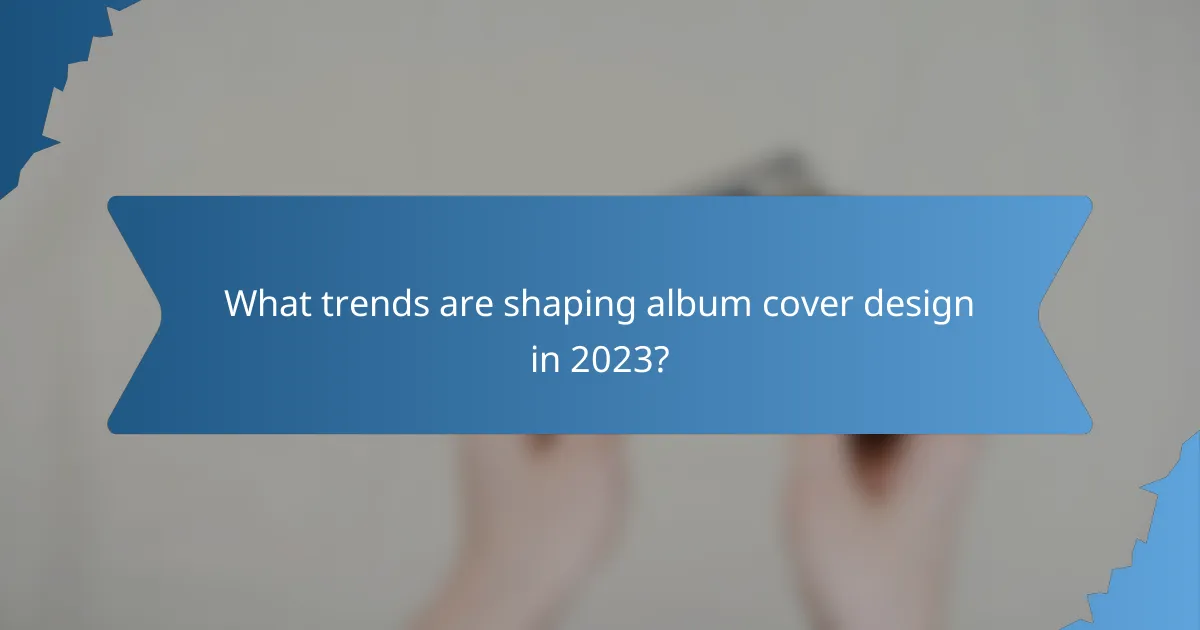
What trends are shaping album cover design in 2023?
In 2023, album cover design is increasingly influenced by minimalism, retro aesthetics, and augmented reality integration. These trends reflect artists’ desires to create impactful visual storytelling that resonates with audiences in a digital-first world.
Minimalism
Minimalism in album cover design emphasizes simplicity and clarity, often using limited color palettes and clean lines. This approach allows the artwork to convey strong messages without overwhelming the viewer, making it memorable and easily recognizable.
Artists can consider using bold typography and negative space to enhance the minimalist effect. For example, a single striking image or a few well-chosen words can create a powerful visual statement that stands out in crowded digital marketplaces.
Retro aesthetics
Retro aesthetics draw inspiration from past decades, often incorporating vintage colors, textures, and design elements. This trend appeals to nostalgia, allowing artists to connect with listeners through familiar visual styles that evoke specific eras.
When designing with retro aesthetics, consider using filters or graphic styles reminiscent of vinyl records or cassette tapes. This can create a sense of authenticity and charm, appealing to both older audiences and younger listeners who appreciate vintage culture.
Augmented reality integration
Augmented reality (AR) integration is becoming a game-changer in album cover design, allowing fans to interact with artwork in innovative ways. By using AR technology, artists can create immersive experiences that enhance the storytelling aspect of their music.
To implement AR, artists can collaborate with developers to create apps or use platforms that support AR features. This can include animations that play when viewers scan the cover with their smartphones, providing additional content like music videos or behind-the-scenes footage, thus deepening fan engagement.

How does visual storytelling impact audience engagement?
Visual storytelling significantly enhances audience engagement by creating a deeper connection through imagery and design. This approach allows artists and brands to convey complex narratives quickly and effectively, leading to a more immersive experience for viewers.
Increased emotional resonance
Visual storytelling fosters emotional resonance by using imagery that evokes feelings and memories. For instance, an album cover featuring nostalgic elements can trigger personal associations, making the music more relatable and impactful. This emotional connection encourages audiences to invest more in the content.
To maximize emotional resonance, consider using colors, symbols, and themes that align with your target audience’s experiences. For example, warm colors may evoke happiness, while cooler tones can convey sadness or introspection.
Enhanced memorability
Effective visual storytelling enhances memorability by creating striking images that stick in the audience’s mind. When visuals are unique and well-crafted, they are more likely to be remembered, leading to increased recognition of the artist or brand. For example, iconic album covers often become synonymous with the music itself.
To improve memorability, focus on simplicity and clarity in your visuals. A clean design with a strong focal point can make a lasting impression, while cluttered images may confuse or distract viewers.
Stronger brand loyalty
Visual storytelling can cultivate stronger brand loyalty by establishing a consistent and relatable identity. When audiences connect with the visual elements of a brand, they are more likely to develop a sense of belonging and attachment. This loyalty can translate into repeat purchases and advocacy.
To build brand loyalty through visual storytelling, ensure that your visuals reflect your brand values and resonate with your audience’s aspirations. Regularly updating visuals while maintaining core themes can keep your brand fresh and engaging without losing its identity.
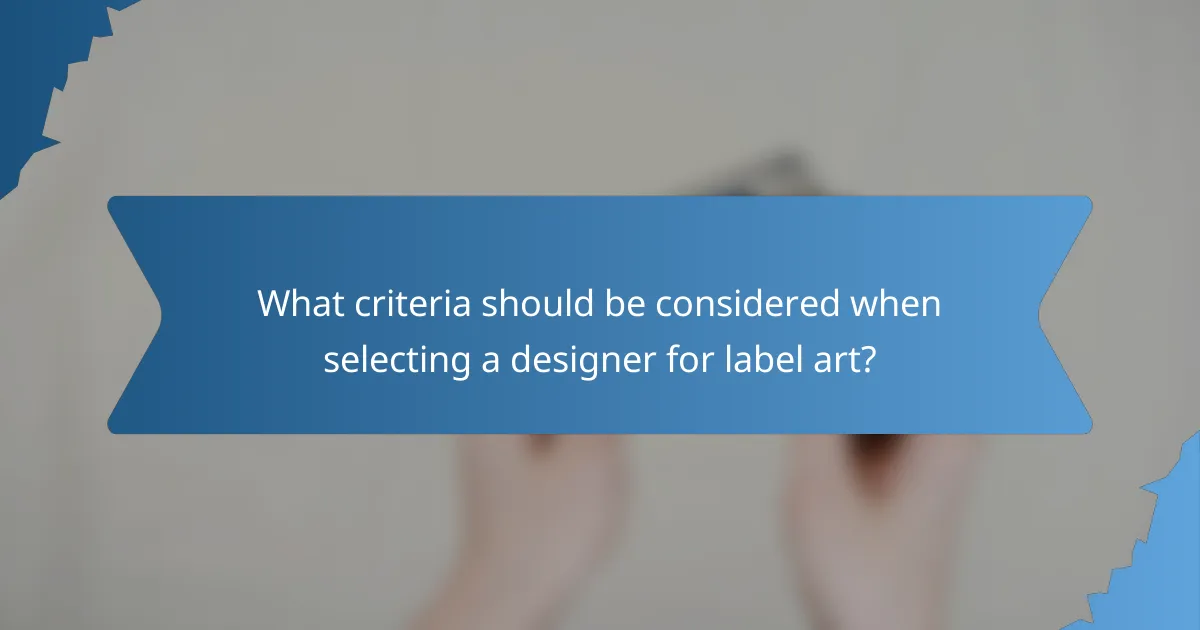
What criteria should be considered when selecting a designer for label art?
When selecting a designer for label art, consider their portfolio, experience with your genre, and ability to convey your brand’s message visually. A good designer should not only create appealing artwork but also understand the nuances of visual storytelling that resonate with your target audience.
Portfolio and Style
Reviewing a designer’s portfolio is crucial as it showcases their artistic style and versatility. Look for previous work that aligns with your vision and genre, whether it’s vibrant and bold for pop music or minimalist for indie. A strong portfolio indicates a designer’s capability to create impactful label art.
Experience with Your Genre
Choosing a designer with experience in your specific music genre can significantly enhance the effectiveness of your label art. Designers familiar with the trends and expectations of your audience can create visuals that resonate more deeply. Consider asking for references or examples of past work in similar styles.
Communication and Collaboration
Effective communication is essential when working with a designer. Ensure they are open to feedback and willing to collaborate closely throughout the design process. A designer who listens to your ideas and incorporates them into their work will likely produce a final product that meets your expectations.
Budget and Timeline
Establishing a clear budget and timeline is vital when selecting a designer for label art. Costs can vary widely, so discuss your budget upfront to find a designer who can work within those parameters. Additionally, clarify deadlines to ensure the project aligns with your release schedule.
